|

 Up
Up 
 Inventing the
Inventing the
Airplane

(You are here.)
 Down
Down




  Need
to Need
to
find your
bearings?
Try
these
navigation aids:
If this
is your first
visit, please stop by:
Something
to share?
Please:



|
|
Available in Française, Español, Português, Deutsch, Россию,
中文,
日本, and others.
 nvention is where poetry and engineering come together. It is a creative endeavor
where the heart beats faster with each intuitive leap, yet success is measured by the
stern, unforgiving ruler of the Scientific Method. It’s not a predictable process;
you never march a straight path to your goal. Instead, you crisscross the same ground over
and over again as you search for the answer that you’re sure is there somewhere. Every
successful invention is the result of false starts, dead ends, disappointments,
self-doubt, perseverance, and the elation that comes when your faith in yourself is at
last rewarded. nvention is where poetry and engineering come together. It is a creative endeavor
where the heart beats faster with each intuitive leap, yet success is measured by the
stern, unforgiving ruler of the Scientific Method. It’s not a predictable process;
you never march a straight path to your goal. Instead, you crisscross the same ground over
and over again as you search for the answer that you’re sure is there somewhere. Every
successful invention is the result of false starts, dead ends, disappointments,
self-doubt, perseverance, and the elation that comes when your faith in yourself is at
last rewarded.
Nowhere is this more evident than in the tale
of the invention of the airplane.
It was one of the most perplexing and dangerous research projects ever attempted, and
it came within a hair’s breadth of death and disaster many times. The Wright brothers
built seven flying machines in their quest for a practical aircraft, each a
test bed for untried theories and assumptions. When they guessed wrong, they crashed -- and
the Wrights crashed each one of their aircraft more than once. However, knowing what
doesn’t work points the way to what does. After each failure, they rebuilt and
modified their aircraft, incorporating what they had learned in the new design. In less
than a decade they taught themselves to fly.
Timeline:
-
1896 The Wright brothers read news
stories of glider pilot Lilienthal's death. They surmise it was caused back lack of
control and begin to think about a control system for an aircraft.
-
1899 to 1899 The Wrights read
everything they can find on aviation and aeronautics.
-
1899 Wilbur is twisting a long, slender
box in his hands when an idea hits him for an aircraft control system. By warping the
wings, he could control roll, banking an aircraft left and right. The brothers test the
concept with a
kite and it works like gangbusters.
-
Spring 1900 to Summer 1900 Wilbur looks around for
a place to test a glider. He settles on Kitty Hawk, North Carolina because the high winds
will help launch a glider and the soft sands will cushion a rough landing.
-
Fall 1900
The Wrights build their
first glider with wing warping controls and fly it a Kitty Hawk. It
does not produce the desired lift, but the controls work well and they are encouraged
enough to try again.
-
Summer 1901 The
second glider is a disappointment. The controls do not work as well as
the first glider, and it produces no more lift. They contemplate giving up their flying
experiments.
-
Fall 1901 to Spring 1902 After a
speech that Wilbur gives to the Western Society of Engineers is well-received, he and
Orville decide to carry on. They test over 200 wings shapes in a wind tunnel to find which
ones produce the most lift. The brothers build a new glider based on the results.
-
Fall 1902 The Wright's
third glider produces the expected lift, but is still hard to control
in a turn. They decided to make the tail movable, and this cures the problem. They make
flight after flight, gliding over 600 feet. They begin to plan a powered machine.
-
Winter 1902 to Summer 1903 The
Wright contact engine manufacturers and look for literature on designing propellers, but
to no avail. They decide to make
their own engine and they invent a
method to design
efficient propellers.
-
Spring 1903 Octave Chanute
tells the Aero-Club de France about the Wright's experiments, and the members begin to
copy Wright gliders in an attempt to beat them into the air with a practical airplane.
-
Fall 1903 to Winter 1903 The
Wrights construct their
first powered flyer at Kitty Hawk while
making practice flights in their 1902 glider. They have trouble with the propeller shafts,
requiring two trips back to Dayton to repair them. They aren't ready to test the Flyer
until mid-December.
-
December 17, 1903 The Wrights
make the first sustained, controlled, powered flights in an airplane, the Flyer 1,
covering up to 852 feet and staying in the air for up to 59 seconds. After four flights,
the aircraft is overturned by a gust of wind and destroyed.
-
Spring 1904 to Summer 1904 The Wrights
build the
Flyer
II, a copy of the Flyer 1. They resume test
flight at Huffman Prairie, a field near Dayton, Ohio, but find their new machine has too
little power to make more than brief hops.
-
Fall 1904 The Wright build a catapult
system to sling their underpowered Flyer 2 into the air. It works well, and they begin to
make progress again. Although they find the Flyer 2 difficult to control, on September 20
they fly the first complete circle in an aircraft.
-
1905 The Wright completely rebuild
their aircraft, salvaging only the engine, propellers, and hardware. The new
Flyer
III is much easier to control, and the Wrights begin to stay in
the air for longer and longer periods of time. On October 5, Wilbur flies for 39 minutes,
covering over 24 miles and running the gas tank dry. The Flyer 3 is the world's first
practical airplane.
Note: You may also want to consult the
Wright Timeline.
|
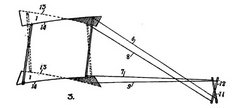
Wilbur built this kite in 1899 to test his theory that he could
roll an aircraft by twisting its wings.
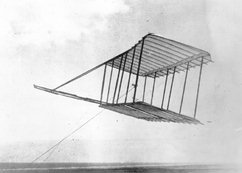
The Wright brothers built their first manned
glider in 1900 and tested it at Kitty Hawk, NC. It did not fly well.

The Wrights' second glider, built in 1901, flew no better than the
first.
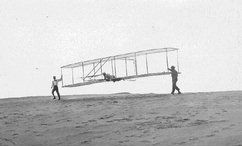
After testing over 200 wing shapes in a homemade wind tunnel, the
Wrights built their third glider in 1903 and found that it flew
reasonably well.
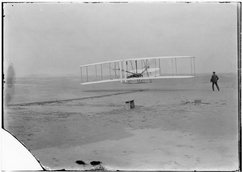
In 1903, the Wright built a powered aircraft and made the first
sustained, controlled powered flights.
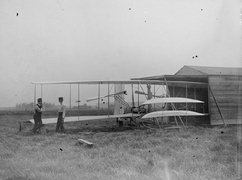
In 1904, they began to perfect their aircraft at Huffman Prairie,
near Dayton, OH.
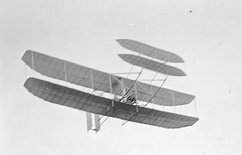
By 1905, they had arrived at what they considered a practical flying
machine.
|

